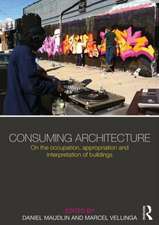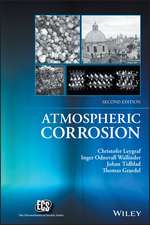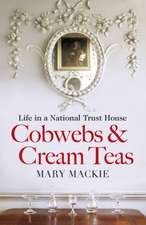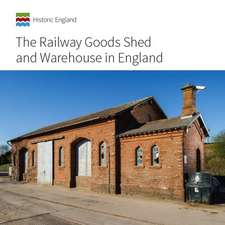The Effects of Air Pollution on Cultural Heritage
Editat de John Watt, Johan Tidblad, Vladimir Kucera, Ron Hamiltonen Limba Engleză Paperback – 10 noi 2014
Trends in pollutant emissions, ambient concentrations and building damage over time are described and future predictions are presented. Methodologies for assessing the extent of the potential problem in a region – the stock at risk – are presented. Procedures for estimating the economic implications are described and the consequences are discussed in detail, because economic factors are important for reaching policy and management decisions at local, national and international scales.
Damage to cultural heritage buildings is an important additional effect which needs to be considered as the standards are revised and the factors which will need to be brought into the assessment are presented.
| Toate formatele și edițiile | Preț | Express |
|---|---|---|
| Paperback (1) | 945.79 lei 6-8 săpt. | |
| Springer Us – 10 noi 2014 | 945.79 lei 6-8 săpt. | |
| Hardback (1) | 950.33 lei 6-8 săpt. | |
| Springer Us – 16 sep 2009 | 950.33 lei 6-8 săpt. |
Preț: 945.79 lei
Preț vechi: 1153.39 lei
-18% Nou
Puncte Express: 1419
Preț estimativ în valută:
180.97€ • 189.46$ • 149.75£
180.97€ • 189.46$ • 149.75£
Carte tipărită la comandă
Livrare economică 07-21 aprilie
Preluare comenzi: 021 569.72.76
Specificații
ISBN-13: 9781461497899
ISBN-10: 1461497892
Pagini: 320
Ilustrații: XIV, 306 p.
Dimensiuni: 155 x 235 x 17 mm
Greutate: 0.45 kg
Ediția:2009
Editura: Springer Us
Colecția Springer
Locul publicării:New York, NY, United States
ISBN-10: 1461497892
Pagini: 320
Ilustrații: XIV, 306 p.
Dimensiuni: 155 x 235 x 17 mm
Greutate: 0.45 kg
Ediția:2009
Editura: Springer Us
Colecția Springer
Locul publicării:New York, NY, United States
Public țintă
ResearchCuprins
Environment, Pollution and Effects Environment, Pollution and Effects .- Monitoring, Modelling and Mapping Monitoring, Modelling and Mapping .- Corrosion Corrosion .- Soiling.- Some Aspects of Biological Weathering and Air Pollution Some Aspects of Biological Weathering and Air Pollution .- Stock at Risk.- Economic Evaluation Economic Evaluation .- Impact and Risk Assessment Risk Assessment and Management Strategies at Local Level.- Air Quality Policy Air Quality Policy .
Textul de pe ultima copertă
This book examines the impact of air pollution on cultural heritage materials, which is a serious concern because it can lead to loss of important parts of our history and culture. Damage includes corrosion, bio-degradation and soiling. In recent years, there have been major changes in both the sources and amounts of emissions of air pollution that have altered the rate and extent of building damage. The book reviews the sources of the air pollutants responsible for building damage and the mechanisms involved. Studies investigating the relationships between pollution concentration (dose) and the resulting damage (response) are described and the latest research findings for dose-response functions presented.
Trends in pollutant emissions, ambient concentrations and changes in building damage over time are discussed and future predictions presented.. Procedures for estimating the economic implications are described and the consequences are discussed in detail, because economic factors are important for reaching policy and management decisions at local, national and international scales. An important part of the economic evaluation relies on having reliable estimates of theactual amounts of material that need to be considered - the stock at risk. This estimation is difficult for heritage materials, since the buildings and monuments involved are very varied in size, shape, age and composition. The most up to date studies are presented, with a number of case studies to show how this subject may be approached.
Damage to cultural heritage buildings is an important effect of air pollution, which needs to be considered as current air quality standards, largely based on health effects, are revised. The factors which will need to be brought into the assessment, including potential ways to address the fact that there is no general consensus on what might be considered a tolerable or acceptable rate, are presented. Finally, a range of possible strategies and methods for conservation and maintenance, as required by building managers, is described and a number of case studies presented.
This book combines the results of recent research with practical information and provides an important reference manual for researchers, policy makers, economists and historic building managers working in the field of cultural heritage protection.
Trends in pollutant emissions, ambient concentrations and changes in building damage over time are discussed and future predictions presented.. Procedures for estimating the economic implications are described and the consequences are discussed in detail, because economic factors are important for reaching policy and management decisions at local, national and international scales. An important part of the economic evaluation relies on having reliable estimates of theactual amounts of material that need to be considered - the stock at risk. This estimation is difficult for heritage materials, since the buildings and monuments involved are very varied in size, shape, age and composition. The most up to date studies are presented, with a number of case studies to show how this subject may be approached.
Damage to cultural heritage buildings is an important effect of air pollution, which needs to be considered as current air quality standards, largely based on health effects, are revised. The factors which will need to be brought into the assessment, including potential ways to address the fact that there is no general consensus on what might be considered a tolerable or acceptable rate, are presented. Finally, a range of possible strategies and methods for conservation and maintenance, as required by building managers, is described and a number of case studies presented.
This book combines the results of recent research with practical information and provides an important reference manual for researchers, policy makers, economists and historic building managers working in the field of cultural heritage protection.
Caracteristici
Combines the results of recent research with practical information for environmental managers
Provides an important reference manual for researchers, policy makers, economists and historic building managers working in the field of cultural heritage materials and their damage due to air pollution
Provides an important reference manual for researchers, policy makers, economists and historic building managers working in the field of cultural heritage materials and their damage due to air pollution















